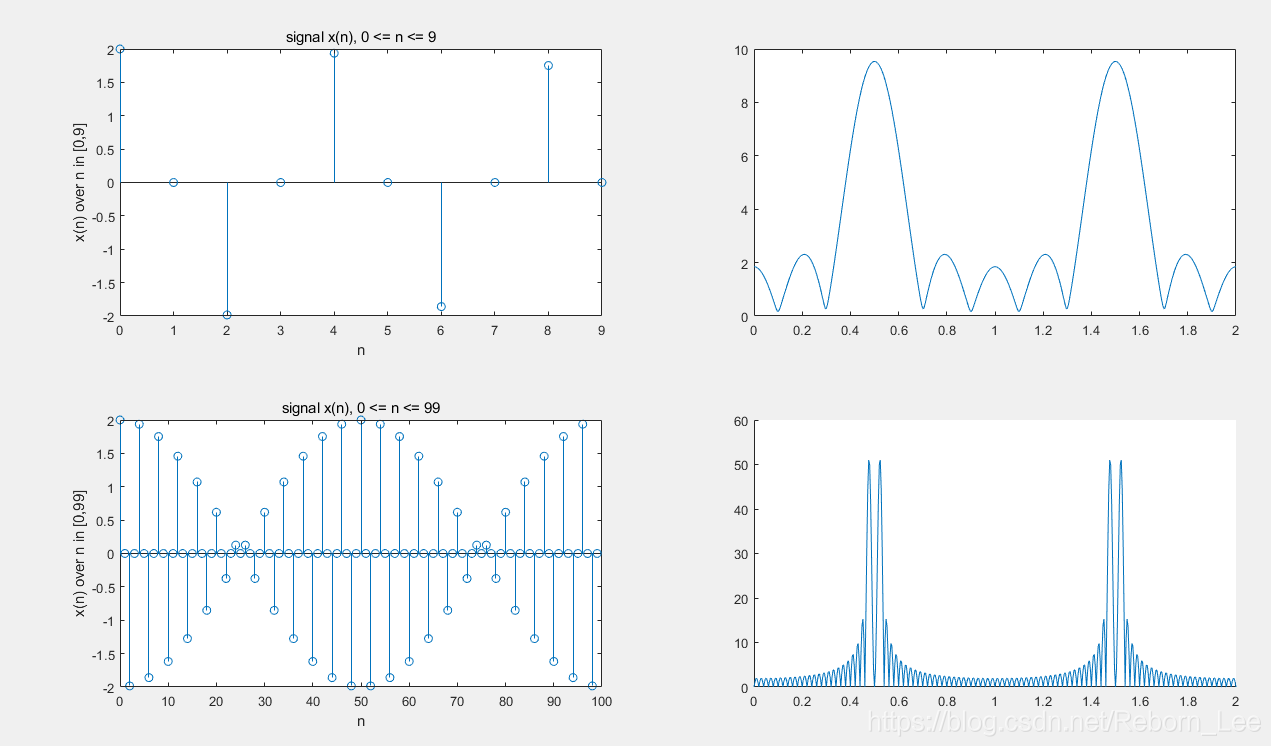【 MATLAB 】通過不同樣本數的同一個有限長序列作 DTFT 對比
阿新 • • 發佈:2018-12-18
可是還是覺得不過癮,還有下面的情況需要對比。於是就有了這篇博文。
案例:
想要基於有限樣本數來確定他的頻譜。
下面我們分如下幾種情況來分別討論:
a. 求出並畫出 的DTFT;
b. 求出並畫出 的DTFT;
clc;clear;close all; n = 0:99; x = cos(0.48*pi*n) + cos(0.52*pi*n); n1 = 0:9; y1 = x(1:10); subplot(2,2,1) stem(n1,y1); title('signal x(n), 0 <= n <= 9'); xlabel('n');ylabel('x(n) over n in [0,9]'); Y1 = dft(y1,10); magY1 = abs(Y1); k1 = 0:1:9; N = 10; w1 = (2*pi/N)*k1; subplot(2,2,2); % stem(w1/pi,magY1); % title('DFT of x(n) in [0,9]'); % xlabel('frequency in pi units'); %In order to clearly see the relationship between DTFT and DFT, we draw DTFT on the same picture. %Discrete-time Fourier Transform K = 500; k = 0:1:K; w = 2*pi*k/K; %plot DTFT in [0,2pi]; X = y1*exp(-j*n1'*w); magX = abs(X); % hold on plot(w/pi,magX); % hold off subplot(2,2,3) stem(n,x); title('signal x(n), 0 <= n <= 99'); xlabel('n');ylabel('x(n) over n in [0,99]'); Xk = dft(x,100); magXk = abs(Xk); k1 = 0:1:99; N = 100; w1 = (2*pi/N)*k1; subplot(2,2,4); % stem(w1/pi,magXk); % title('DFT of x(n) in [0,99]'); % xlabel('frequency in pi units'); %In order to clearly see the relationship between DTFT and DFT, we draw DTFT on the same picture. %Discrete-time Fourier Transform K = 500; k = 0:1:K; w = 2*pi*k/K; %plot DTFT in [0,2pi]; X = x*exp(-j*n'*w); magX = abs(X); hold on plot(w/pi,magX); hold off

可見,b問這種情況,擁有x(n)的更多資料,所以得到的DTFT更加的準確,正如我們所料,頻譜在w = 0.48pi以及0.52pi處取得峰值。而a問中的圖就看不出這種關係,因為獲得序列資料太少,已經嚴重影響到了頻譜的形狀。
